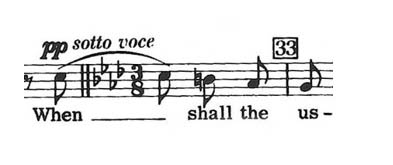Tippett’s secular oratorio was written in response to the 1938 shooting of a German official by a Polish Jewish refugee, Herschel Grynzspan, which resulted in the Kristallnacht.
The composition has several references to a “Jewish motif” 1, which is (typically) a descending succession of 4 notes: a half note followed by an augmented second interval and another half note.
Here are four randomly picked examples from the work:
No. 3 Scena:

Same movement with the first two notes switched (illustrating the “we are lost”?)

#5 chorus of the oppressed:

# 28 Scena (page 89): (the A can be viewed as an incidental note)

Can this succession of 4 notes be considered a leitmotif 2 in this work?
Interesting to note that the occurrences of this motif either pass by fast, or are embedded in complex harmony such that they are hard, if not impossible, to internalize in a single listen.
To me, the inclusion of this motif, as subtle as it is, demonstrates Tippett’s breadth and depth of this complex work.
For those of us who sang in 2013, here’s the beginning of Oseh Shalom Bimromav, composed by Michael Schachter, the winner of our 2013 Young Composer Competition, where the Jewish motif in it is quite apparent.
1 This motif is used too in other world music, such as Arabic and Balkan.
2 A recurrent theme throughout a musical or literary composition, associated with a particular person, idea, or situation.
— Gabriela Crane
